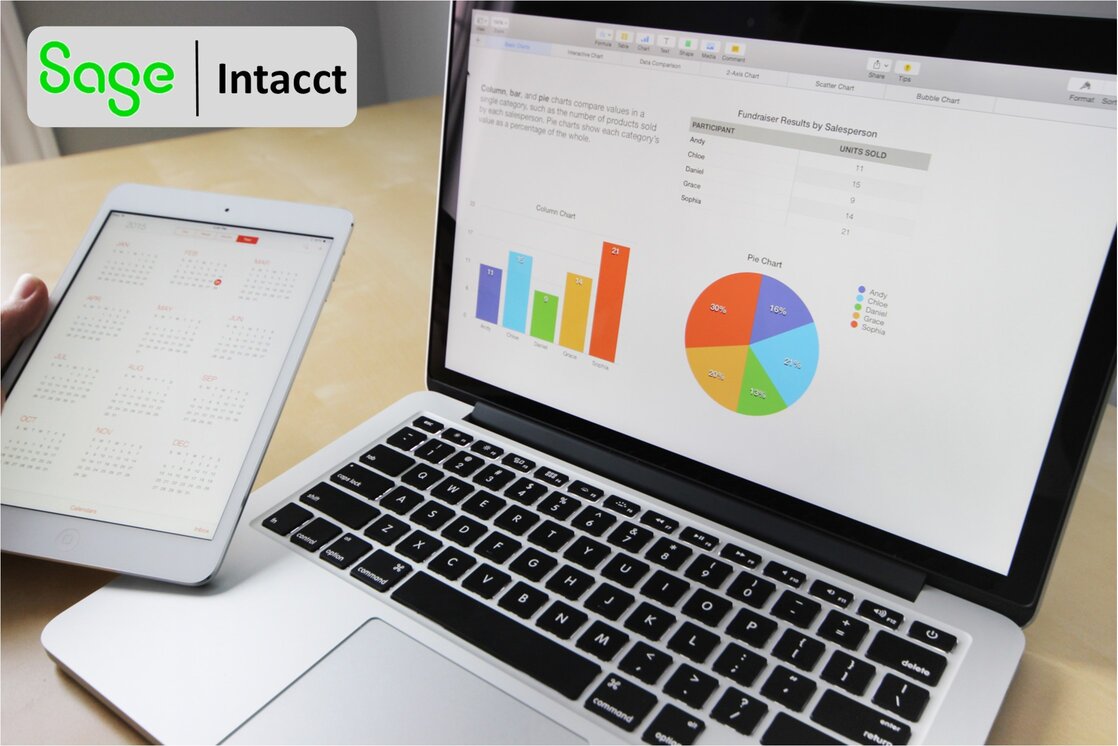SMEs are seen as the backbone of global society, and running a small business can be complex. Accurate financial reporting and analysis are crucial for managing and understanding the finances of a small business.
Understanding and effectively managing your company's financial performance is crucial in today's fast-paced business environment. Financial reporting and analysis are essential processes that provide valuable insights into an organization's financial health, enabling informed decision-making for management, investors, partners, and other stakeholders. Sage Intacct, a trusted cloud-based financial management solution, is here to revolutionise your financial reporting and analysis capabilities, giving your business the edge it needs to thrive.
In this comprehensive guide, we'll delve into the world of financial reporting and analysis, discuss the benefits, and demonstrate how Sage Intacct can streamline these processes to transform your business.
Financial reporting and analysis explained
Financial reporting and analysis are the processes of collecting, organising, summarising, and interpreting financial data to understand a company's or organisation's financial performance, position, and changes. It is critical to provide valuable insights to various stakeholders, such as management, investors, partners, regulators, and others, to assist them in making informed decisions.
What is financial reporting?
Typically, financial reporting entails preparing and presenting financial statements, which are standardised documents that provide a snapshot of a company's financial health over a specific period. The following are examples of critical financial statements:
- Balance sheet: A report showing a company's assets, liabilities, and equity at a given time.
- Income statement: A document that summarises a company's revenues, expenses, and net income (or loss) over a specific period.
- Cash flow statement: The cash inflows and outflows from operating, investing, and financing activities over a specific period are detailed in the cash flow statement.
- Statement of equity changes: This shows how a company's equity components, such as retained earnings and share capital, have changed over time.
What is financial analysis?
On the other hand, financial analysis involves examining and evaluating these financial statements using various tools, techniques, and ratios. This helps assess the company's profitability, liquidity, solvency, efficiency, and overall financial performance. Some standard financial analysis techniques include horizontal and vertical analysis, ratio analysis, trend analysis, and benchmarking.
The benefits of financial reporting and analysis

Financial reporting and analysis offer numerous benefits for businesses, providing valuable information that helps with decision-making, performance evaluation, and future planning. Some key benefits include the following:
Financial reporting and analysis provide insights into a company's financial health, enabling management to make well-informed decisions on investments, resource allocation, expansion, and other strategic initiatives.
Regular analysis of financial statements helps businesses assess their performance against predetermined goals, objectives, and industry benchmarks. This enables management to identify areas of strength and weakness, allowing them to address any issues and capitalise on growth opportunities.
Transparent and accurate financial reporting is essential for businesses seeking to raise funds from investors or secure loans from financial institutions. Reliable financial information instils confidence in investors and creditors, increasing the likelihood of obtaining financing.
Businesses must comply with various accounting standards and regulations, such as GAAP (Generally Accepted Accounting Principles) or IFRS (International Financial Reporting Standards). Financial reporting ensures that businesses adhere to these standards, reducing the risk of non-compliance penalties.
-
Enhancing stakeholder confidence
Regular financial reporting and analysis demonstrate a commitment to transparency and accountability, increasing the trust and confidence of stakeholders, such as shareholders, creditors, employees, and customers.
Financial analysis helps businesses identify potential risks and assess their impact on the company's financial performance. This enables management to develop strategies to mitigate these risks and safeguard the company's financial health.
-
Improved financial control
Financial reporting and analysis promote better financial control by enabling businesses to monitor cash flow, manage working capital, and control expenses. This contributes to increased efficiency and profitability.
The insights gained from financial analysis help businesses develop informed strategic plans by identifying trends, growth opportunities, and potential challenges. This ensures that companies are better equipped to navigate future uncertainties and capitalise on market opportunities.
The financial reporting process: a step-by-step guide

Financial reporting is a systematic procedure through which companies collect, organise, summarise, and present their financial information as financial statements. This process helps businesses communicate their financial health to stakeholders, such as investors, creditors, partners, regulators, and management. The financial reporting process generally consists of the following steps:
Step 1: Transaction recording
The process begins with recording financial transactions as they occur, using a double-entry bookkeeping system. This involves entering debits and credits for each transaction in the company's general ledger, which serves as the central repository for all financial data.
Step 2: Posting to subsidiary ledgers
Subsidiary ledgers are specialised records that track specific types of transactions, such as accounts receivable, accounts payable, inventory, and fixed assets. After recording transactions in the appropriate subsidiary ledger, the relevant data is posted to the general ledger, ensuring detailed information is available for specific accounts.
Step 3: Adjusting entries
At the end of the accounting period, entries are made to ensure that the company's financial records adhere to the accrual accounting method. These adjustments typically involve recognising revenues and expenses at the time they are earned or incurred, regardless of when cash is received or paid.
Step 4: Preparing a trial balance
A trial balance is prepared to check the accuracy of the general ledger accounts. This report lists all accounts and their balances, ensuring that the total debits equal the total credits. If discrepancies are found, they must be investigated and corrected before proceeding.
Step 5: Preparing financial statements
Using the adjusted trial balance, the company prepares its financial statements, including the balance sheet, income statement, cash flow statement, and statement of changes in equity. These statements present a snapshot of the company's financial health and performance for the specific reporting period.
Step 6: Closing entries
After preparing the year end financial statements, closing entries are made to reset the income statement accounts, such as revenues and expenses, to zero. This process helps to record the next accounting period's financial transactions accurately. This is normally an automatic process carried out by your accouting software.
Step 7: Preparing a post-closing trial balance
A post-closing trial balance is prepared to verify that the closing entries have been accurately recorded and that the general ledger is ready for the next accounting period.
Step 8: Financial statement analysis
Once the financial statements are prepared, they are analysed to assess the company's financial performance, position, and trends. This analysis may include ratio analysis, trend analysis, and benchmarking against industry peers.
Step 9: External audit (if applicable)
For publicly traded companies and some other organisations, an independent accounting firm conducts an external audit to verify the accuracy and fairness of the financial statements. The auditors issue an opinion on whether the financial statements are presented fairly and follow the applicable accounting standards.
Step 10: Disclosure and dissemination
The final step in the financial reporting process involves disclosing the financial statements and other relevant information to stakeholders, such as investors, creditors, partners and regulators. Public companies typically release their financial statements through annual and quarterly reports, press releases, and regulatory filings.
The benefits of Sage Intacct for reporting and analysis
 Empower your business decisions with Sage Intacct Reporting: Unleash the power of data
Empower your business decisions with Sage Intacct Reporting: Unleash the power of data
Sage Intacct is a cloud-based accounting and financial management software designed to help businesses automate financial processes, improve reporting and analysis, and streamline financial operations. It caters to a wide range of industries, including non-profit organisations, professional services, healthcare, and more.
Some key benefits of using Sage Intacct for reporting and analysis include:
Sage Intacct provides real-time access to financial data, enabling businesses to make informed decisions based on up-to-date information. This ensures that management has the most accurate and current insights for decision-making and performance evaluation.
The software offers customisable reporting options, allowing businesses to create tailored reports that meet their specific needs. Users can easily create reports with various filters, sorting options, and visualisation tools to understand their financial data better and gain valuable insights.
-
Multi-dimensional analysis
Sage Intacct enables multi-dimensional analysis by allowing users to tag transactions with various dimensions, such as location, department, project, or customer. This feature helps businesses analyse their financial data from different perspectives, providing a more comprehensive understanding of their financial performance.
-
Automation of financial processes
Sage Intacct automates many financial processes, such as transaction entry, reconciliation, and report generation. This helps reduce manual errors, save time, and improve financial reporting and analysis efficiency. For example set-up schedules and reports can be automatically emailed to receipants saving you countless hours running and dispatching reports.
-
Integration with other systems
The software integrates with various third-party applications, such as CRM, payroll, and budgeting tools. This allows businesses to easily consolidate data from different sources for more comprehensive reporting and analysis.
As a cloud-based solution, Sage Intacct enables team members to access financial data and collaborate on reports from anywhere, at any time. This promotes better communication and collaboration among team members and ensures that all stakeholders have access to the most current financial information.
Sage Intacct is designed to grow with your business, offering scalable features that can accommodate changing needs and requirements. This ensures that businesses can continue to benefit from the software's reporting and analysis capabilities as they expand and evolve.
The software is designed to help businesses maintain compliance with various accounting standards and regulations. Additionally, Sage Intacct prioritises data security, employing stringent measures to protect sensitive financial information.
Transform your business with Sage Intacct
If you are looking to elevate your financial management and achieve unprecedented growth, Sage Intacct is a game-changer. This powerful, cloud-based financial management solution has already helped numerous companies unlock their true potential.
Sage Intacct has earned the trust of more than 17,000 businesses across the globe by supporting their financial transformation. This powerful financial management solution is specifically tailored for mid-sized and expanding companies, providing them with the convenience and flexibility of a cloud-based platform accessible anytime and from anywhere.
Moreover, our clients have experienced an astounding average ROI of 250% with Sage Intacct, often recouping their investment within just six months. It's time to join the ranks of successful businesses that have revolutionised their financial management with Sage Intacct.
Get in touch with us today to learn how Sage Intacct can transform your business and set you on the path to unparalleled success.
You may also like ...